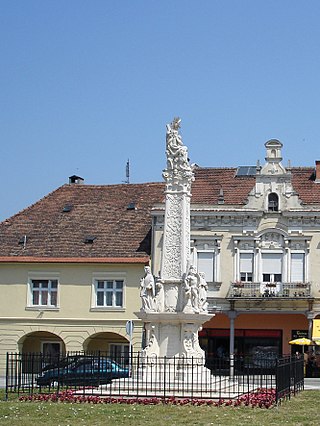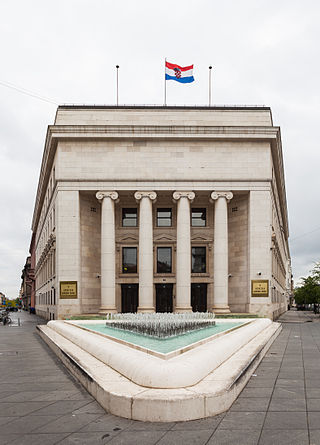
Zagreb is the capital and largest city of Croatia. It is in the north of the country, along the Sava river, at the southern slopes of the Medvednica mountain. Zagreb stands near the international border between Croatia and Slovenia at an elevation of approximately 122 m (400 ft) above sea level. The population of the Zagreb urban agglomeration is 1,271,150, between a quarter and a third of the total population of Croatia, while at the 2021 census, the city itself had a population of 878,131.

Požega is a city in western Slavonia, eastern Croatia, with a total population of 22,364. It is the administrative center of the Požega-Slavonia County.

Prešeren Square is the central square in Ljubljana, the capital of Slovenia. It is part of the old town's pedestrian zone and a major meeting point where festivals, concerts, sports, political events, and protests take place. It was renovated in 2007.
Viktor Kovačić (1874–1924) was a Croatian architect and is often called "the father of modern Croatian architecture".

Vodnjan is a town in Istria County, Croatia, located about 10 kilometers north of the largest city in Istria, Pula.

Ban Jelačić Square is the central square of the city of Zagreb, Croatia, named after Ban Josip Jelačić. The official name is Trg bana Jelačića. The square is colloquially called Jelačić plac.

The St. Mark's Church or the Church of St. Mark is a Serbian Orthodox church located in the Tašmajdan park in Belgrade, Serbia, near the Parliament of Serbia. It was built in the Serbo-Byzantine style by the Krstić brothers, completed in 1940, on the site of a previous church dating to 1835. It is one of the largest churches in the country. There is a small Russian church next to St. Mark's.

The history of Zagreb, the capital and largest city of Croatia, dates back to the Middle Ages. The Romans had built a settlement, Andautonia, in present-day Ščitarjevo. The name "Zagreb" was first used in 1094 at the founding of the Zagreb diocese in Kaptol, after the Slavs had arrived in the area. Zagreb became a free royal city in 1242. It was made the capital of Croatia in 1845 and elected its first mayor, Janko Kamauf, in 1851. According to the 2011 Croatian census, Zagreb had 792,875 inhabitants and was also Croatia's largest city by area.

Banski Dvori is a historical building on the west side of St. Mark's Square in Zagreb, Croatia. It served as the official residence of the Croatian Bans (viceroys) and currently houses the Croatian Government.

Eugen Kvaternik Square is a square located on the border between Maksimir, Gornji Grad - Medveščak and Donji Grad city districts of Zagreb, Croatia. Named after Eugen Kvaternik, a 19th-century politician, it marks the intersection of Vlaška Street, Dragutin Domjanić Street, Maksimirska Street, Vjekoslav Heinzel Avenue, and Šubićeva Street. Kvaternik Square is one of the most frequented squares in Zagreb.
Pantovčak is a neighborhood in Zagreb, Croatia. Its formal location is the Gornji Grad - Medveščak city district. The Pantovčak street runs from the Britanski trg near Ilica towards Medvednica, ending at Šestinski vijenac. The neighbourhood is officially referred to as "Dr. Stjepan Radić" and it has a population of 4,957 (2011).

The Cathedral of the Transfiguration of the Lord is a Serbian Orthodox cathedral located on the Petar Preradović Square in Zagreb, Croatia. It was built in 1865–66 according to designs of architect Franjo Klein. It is ecclesiastically part of the Metropolitanate of Zagreb and Ljubljana and is known as the Zagreb Orthodox Cathedral.

Zagreb Glavni kolodvor is the main railway station in Zagreb, Croatia. Located 1 km (0.62 mi) south of the city's main square, it is the largest station in Croatia and the main hub of the Croatian Railways network.

British Square, colloquially known as Britanac, is a public square in the city of Zagreb, Croatia. It is one of the few remaining squares to include an open-air farmers' marketplace with fresh fruit, vegetables and other foods brought directly from farms, and is a revered urban area among the population of Zagreb. Britanski trg is located along Ilica Street, a few blocks west from the main city square, Ban Jelačić Square. It is also a transport hub—it is an endpoint for several bus lines, while the city tram lines 1, 6 and 11 stop on its south side. The square itself is convenient for access to several elite upscale neighborhoods of Zagreb, such as Pantovčak and Zelengaj. The open air market is held daily from early morning until about noon, and an antiques fair is held at the square each Sunday.

Republic of Croatia Square is one of the biggest squares in Zagreb, Croatia. The square is located in Lower Town, with the Croatian National Theatre building at its centre. It is sometimes billed as the "most beautiful square in Zagreb".

The Church of St. Mark is the parish church of old Zagreb, Croatia, located in St. Mark's Square. It is one of the oldest architectural monuments in Zagreb.

The Lenuci Horseshoe or the Green Horseshoe is a U-shaped system of city squares with parks in downtown Zagreb, Croatia. The horseshoe was conceived in 1882 by Croatian urbanist Milan Lenuci. The parks were designed between 1883 and 1887, at a time when today's Donji grad formed the southern outskirts of Zagreb. The construction was helped by the efforts to rebuild the city after the 1880 Zagreb earthquake, and in 1889 the entire horseshoe was finished—its two ends were connected by the newly built Zagreb Botanical Garden. The park system consists of seven squares aligned on three straight lines.

Croatian Nobles Square is one of the central squares in Zagreb. It was designed in 1923 urban plan as entry to the then new eastern part of the town. Draškovićeva street is on the western side of the square, Martićeva street begins on the north side, while a road and tram line go through the middle of the square to the Rački street and Square of the Victims of Fascism.

The 2020 Zagreb shooting, commonly referred to as the St. Mark's Square attack, occurred on 12 October 2020 in Zagreb, Croatia, when 22-year-old Danijel Bezuk approached Banski dvori, which houses the office of the Prime Minister and serves as the meeting place of the government, on St. Mark's Square and started shooting at it with an assault rifle, wounding a police officer in the process. In the aftermath, the perpetrator ran off to a nearby neighborhood and committed suicide.


















